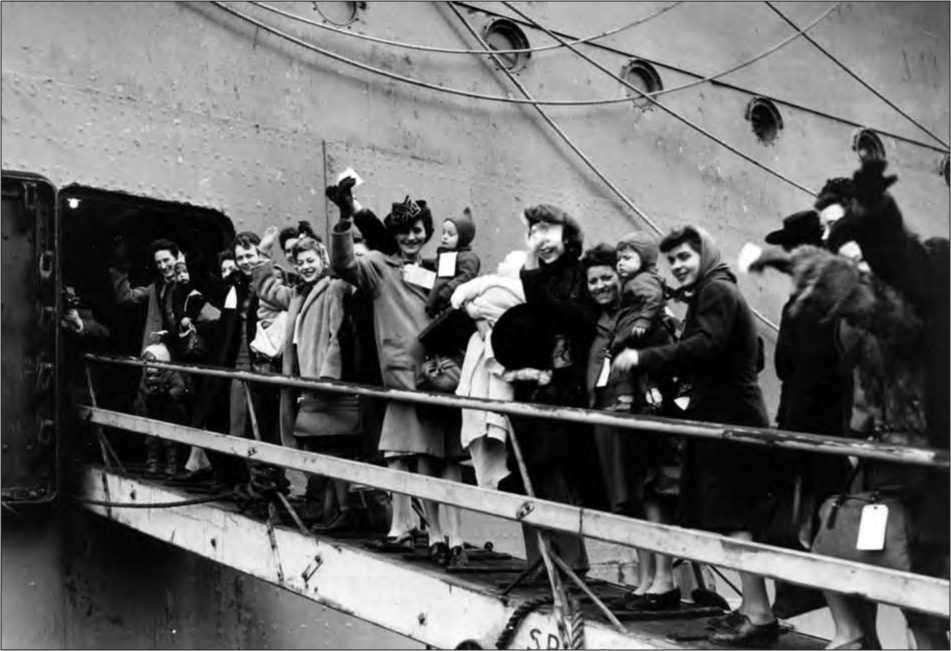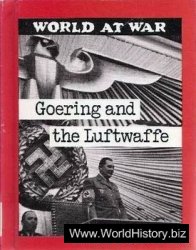The Event: Immigration of foreign-born
Spouses of Americans serving abroad during World War II, most of whom entered the United States either as nonquota immigrants under provisions of the War Brides Act of 1945 or as nonimmigrants under provisions of the Fiancees Act of 1946 Date: 1945-1950
Location: Western Europe; East Asia; Australia
Significance: Throughout U. S. history, American military personnel and civilians serving abroad during times of foreign wars have returned home with foreign spouses. Not surprisingly, the conflict that brought home the largest number of “war brides”—a term encompassing both wives and hus-bands—was World War II. Indeed, so large was the number of war brides that the U. S. Congress enacted special legislation to accommodate their immigration. Precise statistics on their numbers are not available. However, under provisions of the War Brides Act of 1945 alone, 114,691 women and 333 men immigrated to the United States between 1945 and 1950. Thousands more immigrated under other immigration laws.
On December 28, 1945, a little more than four months after World War II officially ended, the U. S. Congress passed the War Brides Act. Six months later, it passed the Fiancees Act. Both laws were designed to facilitate the immigration of spouses of Americans who had served abroad during the war. Under the War Brides Act, visa requirements for foreign-born spouses were waived, with the exception of foreign-born spouses from South and Southeast Asia. Records kept by the U. S. Immigration and Naturalization Service (INS) provide statistics on the numbers of war brides who came from different countries under the provisions of the War Brides Act. However, because many spouses immigrated under provisions of other laws, the INS figures do not tell the entire story.
European War Brides
British-born spouses and their children were by far the largest cohort of war brides to enter the United States after World War II. The reasons are readily evident.
The U. S. Immigration and Naturalization Service (INS) recorded a total of 35,469 people who entered the United States between 1945 and 1950 under the provisions of the War Brides Act. These figures included 34,944 wives, 53 husbands, and 472 children. Other sources, however, have estimated that as many as 70,000 British women may have married American serviceman.
The first group of them left for the United States from Southampton aboard the SS Argentina on January 26, 1946. The average age of the women was about twenty-three. Most were from working-class and lower-middle-class families and had attended school only through the age of fourteen.
Although France, like Great Britain, was an American ally during World War II, it had a vastly different relationship to the American military. Most of France was occupied by Nazi Germany throughout the war, and American troops did not begin encountering French women until after the Allied invasion of France began inJune, 1944. Over the ensuing year, millions of American servicemen contributed to France’s liberation from German occupation. Some of them took up relationships with French women, who were popularly perceived in the United States as being sexually debauched “oh-la-la girls.” According to INS records, between 1945 and 1950, 8,581 French-born wives of Americans with 140 children and 23 French-born husbands of American women entered the United States under provisions of the War Brides Act.
German war brides were a special case, as they were nationals of an enemy power. In September, 1944, the U. S. military officially banned servicemen from fraternizing with German women after the war. The underlying reason was a fear of Nazi sympathizers. Despite this ban, many Americans formed romantic liaisons with German women after the war. As early as 1944, some of these servicemen petitioned the military to allow them to marry their German sweethearts.
In 1946, twenty-three-year-old Robert J. Lauen-stein became the first American serviceman to receive permission to marry a German-born fiance. Lauenstein reportedly exploited a loophole in the Fiancees Act of 1946 to obtain an exit permit for his fiance. His highly publicized marriage to the woman in November, 1946, effectively set a precedent for other American servicemen to marry German-born women. In December, the U. S. Army revoked its ban on marriages to Germans. By 1949, as many as 20,000 German war brides appear to have immigrated to the United States.
Italy, Germany’s primary European ally during the war had a very different wartime experience. It was the first Axis territory to be occupied by Allied troops, who began entering it from the south in 1943. However, the large number of American troops in the Allied occupation force resulted in comparatively few Italian war brides. According to INS figures, only 9,728 Italian-born spouses of Americans immigrated to the United States between 1945 and 1950.
Australian War Brides
The Pacific theater of the war took many American service personnel to Australia, from which operations against Japanese positions in Southeast Asia were mounted. As in Europe, many American personnel took up relations with Australian citizens. According to INS records, during the five years after the war, 6,853 Australians entered the United States under provisions of the War Brides Act. All were wives of Americans, except for 7 husbands and 175 children. Other sources, however, suggest that the number of Australian wives coming to the United States could have been as high as 15,000.
Like the French wives of American servicemen, the Australian wives were negatively stereotyped as morally loose, money-hungry “good-time girls,” who were suspected ofmarrying Americans merely to go to the United States. Responding to a request by the U. S military in 1942, the American Red Cross investigated the backgrounds of potential Australian and British brides until public objec-

British war brides departing for the United States shortly after World War II. (Popperfoto/Getty Images)
Male “War Brides”
Because the numbers of foreign-born men who married American servicewomen were minuscule in comparison to those of foreign-born women who married American men, the term “war brides” was loosely applied to both husbands and wives who entered the United States after World War II.
In 1949, the Hollywood film I Was a Male War Bridge, starring Cary Grant in the title role, helped draw attention to the fact that not all “war brides” were women. The film was based on the real-life story of Belgian army officer Henri Rochard (also known as Dr. Roger H. Charlier), who married an American woman serving with the U. S. military in Europe. A popular hit, the film won the Writers Guild Award for best American comedy of 1949.
Tions brought an end to the investigations ended before the conclusion of World War II.
Asian War Brides
U. S. involvement in the Pacific theater of the war also took many American service personnel to China. At the beginning of the war, almost no Asian immigration to the United States was permitted under U. S. immigration laws enacted during the 1920’s. A law enacted in 1943 eased restrictions on Chinese immigration but only slightly. Consequently, most postwar female Chinese immigrants to the United States had to be admitted under the War Brides Act.
During World War II, 12,041 Chinese Americans were drafted into the U. S. military, and many of them served in China. Under the terms of a special federal law that allowed servicemen to bring home alien wives, 2,317 Chinese women immigrated to the United States between 1947 and 1950. Another 5,132 women immigrated under the War Brides Act. These Chinese immigrants were, on average, older than war brides from other countries. Fully 85 percent of them were at least twenty-six years old.
The major combatants in World War II, Japan provided the smallest number of war brides to immigrate to the United States. Between 1945 and 1950, only 758Japanese came to the United States under the War Brides Act.
Social, Cultural, and Political Implications
The War Brides Act expired in December, 1948, but it had a lingering impact on immigration. which included the delayed transportation of many foreign-born dependents of American service personnel to the United States. An acute shortage of seafaring passenger ships slowed the transportation of war brides. Moreover, restrictive U. S. immigration laws complicated some marriages and delayed the arrival of many war brides. Japanese war brides were particularly affected, as they were not permitted entry into the United States until 1952.
An ironic effect of the War Brides Act was its impact on the gender balance of foreign immigrants. Although the law itself was gender-neutral, it facilitated the immigration of women far more than it did men. Before the war, male immigrants had greatly outnumbered female immigrants. This shift was particularly evident in postwar immigration from China, more than half of whose immigrants were women for the first time.
Nicole Anae
Further Reading
Esser, Raingard. “‘Language No Obstacle’: War Brides in the German Press, 1945-49.” Women’s History Review 12, no. 4 (December, 2003): 577603. Study of depictions of German war brides in German newspapers and magazines published in the American and British zones during the late 1940’s.
Hibbert, Joyce, ed. The War Brides. Toronto, Ont.: PMA Books, 1978. Broad survey of World War II era war brides.
Kaiser, Hilary. French War Brides in America: An Oral History. Westport, Conn.: Praeger, 2008. Collection of oral histories, detailing the destinies of fifteen French war brides from both World War I and World War II.
Shukert, Elfrida Berthiaume, and Barbara Smith Scibetta. War Brides of World War II. Novato, Calif.: Presidio Press, 1988. General overview of World War II war brides.
Virden, Jenel. Good-bye, Piccadilly: British War Brides in America. Champaign: University of Illinois Press, 1996. Often cited study arguing that British war brides represented the largest single group offemale immigrants to the United States in the immediate post-World War II years.
Zhao, Xiaojian. Remaking Chinese America: Immigration, Family, and Community. New Brunswick, N. J.: Rutgers University Press, 2002. Examination of changes to American culture in the wake of postwar immigration legislation favoring family reunification for Chinese American service personnel.
See also: Families; Fiancees Act of 1946; Intermarriage; Mail-order brides; Marriage; Picture brides; Quota systems; War Brides Act of 1945; Women immigrants; World War II.




 World History
World History









